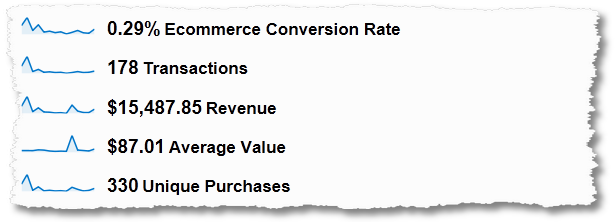Cómo hacer una web optimizada para SEO

Ahora que ya sabes qué es el SEO y cuáles son los principales factores que Google tiene en cuenta a la hora de posicionar una web lo que te falta es saber qué es lo que tienes que hacer para que tu página web tenga oportunidades reales de posicionar.
En este capítulo vamos a hablar sobre como optimizar los principales factores de posicionamiento así como los principales problemas SEO que surgen a la hora de optimizar una web y sus posibles soluciones.
Los temas que se van a tratar en este capítulo los dividiremos en 3 grandes bloques:
- Accesibilidad e indexabilidad
- Contenido
- Factores técnicos
Accesibilidad
Lo primero que hay que hacer a la hora de optimizar una web a para que esta sea accesible para Google en ponernos en la piel de Google. Los usuarios no ven una página web del mismo modo en que la ve un motor de búsqueda, para saber si lo que Google ve es lo que queremos que vea tenemos que seguir una serie de pasos:- Instala este plug-in: Web developer para Mozilla Firefox o Google Chrome
- Desactiva el Javascript Esto lo hacemos porque si los menús desplegables por Javascript no son accesibles por Googlebot no podrá rastrear los enlaces que contenga
- Desactiva los CSS El CSS se desactiva porque Google lee una página en el orden del HTML. Los CSS a veces cambian de lugar los objetos de una página.
- ¿Cómo se ve tu web sin Javascript ni CSS?
Google Chrome

Mozilla Firefox

Google Chrome

Mozilla Firefox
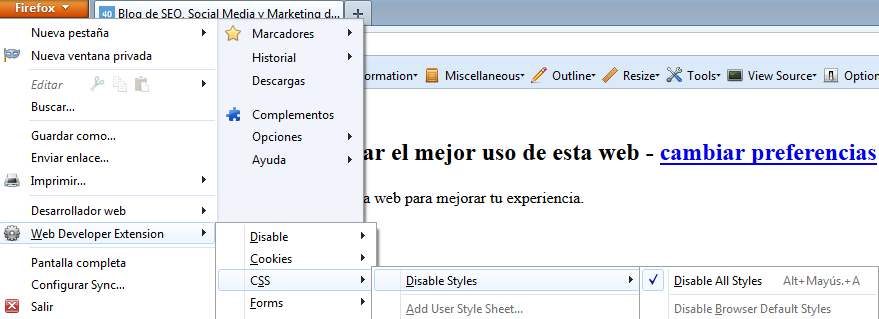
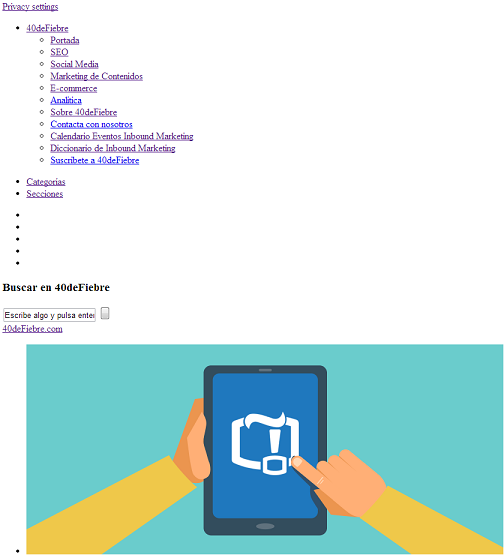 Tienes que tener varias cosas en cuenta cuando compruebes tu página web a los ojos de Google:
Tienes que tener varias cosas en cuenta cuando compruebes tu página web a los ojos de Google:- ¿Puedes ver todos los enlaces de tus menús?
- ¿Todos los enlaces aparecen como texto plano?
- ¿Todos los enlaces son clicables?
- ¿Hay alguna porción de texto que antes no estaba? Si es así trata de arreglarlo cuanto antes, aunque sea involuntario está es una falta muy grave para Google, para él significa que estás ocultando texto a tus usuarios.
- ¿Está tu sidebar o los widgets de tu web en la parte superior de la página? Es importante que los enlaces más importantes estén en la parte de superior de la página.
Principales problemas de accesibilidad
Hay muchos factores que hacen que una web sea más o menos accesible para Google pero hay ciertos problemas que pueden hacer que el robot de Google no llegue a todas las páginas de nuestra web, sobre todo a las más profundas:Estructura de la web
Si la estructura de una web es demasiado profunda ha Google le resultará más difícil llegar a todas las páginas, se recomienda que la estructura no tenga más de 3 niveles de profundidad (sin contar la home) ya que el robot de Google tiene un tiempo limitado para rastrear una web y cuantos más niveles tenga que atravesar menos tiempo le quedará para acceder a las páginas más profundas, por eso siempre se recomienda crear un estructura web en horizontal y no en vertical:Estructura vertical
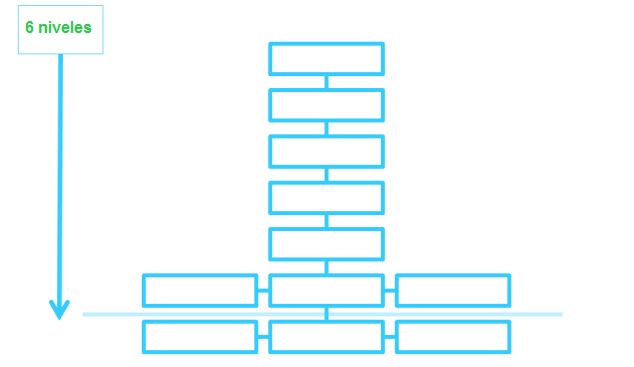
Estructura horizontal
 Como puedes ver, en el segundo diagrama la información de la web está
mucho mejor organizada por categorías y es mucho más accesible para el
robot de Google.
Como puedes ver, en el segundo diagrama la información de la web está
mucho mejor organizada por categorías y es mucho más accesible para el
robot de Google.Enlazado interno
El robot de Google usa lo enlaces de una web para viajar entre las páginas y así poder indexarlas, entonces ¿qué pasa si una página concreta de una web no tiene ningún enlace interno ni externo apuntando hacia ella? Pues que el robot de Google no puede acceder a ella.Es muy importante asegurarse de que todas las páginas de una web tienen al menos un enlace hacia ellas, para comprobar esto usaremos Screaming Frog. Para ello solo tenemos que ejecutar el programa, configurar el filtro para que nos muestre solo las páginas con contenido HTML y hacer scroll hacia la derecha buscando la pestaña “inlinks”.
Por esta razón es muy importante tener una estructura horizontal ya que nos resultará mucho más fácil crear una buen red de enlaces internos
Velocidad de carga
Esto es algo que veremos en detalle más adelante en este mismo capítulo, pero hay que tener en cuenta que además de afectar al posicionamiento en sí tener un tiempo de carga muy alto en una web significa que el robot de Google agotará el tiempo que pase en dicha web sin haber accedido a todas las páginas de la misma.Indexabilidad
Una vez que el robot de Google ha accedido a una página el siguiente paso es que la indexe, estás páginas se incluyen en un índice donde se ordenan según su contenido, su autoridad y su relevancia para que luego sea más sencillo y rápido para Google acceder a ellas.¿Cómo comprobar si Google ha indexado mi web correctamente?
Lo primero que tienes que hacer para saber si Google ha indexado tu web correctamente es hacer una búsqueda con el comando “site:”, de este modo Google nos dirá la cifra aproximada de las páginas de nuestra web que tiene indexadas: Si tienes vinculado Google Webmaster Tools en tu web también puedes comprobar el número real de páginas indexadas desde Indice de Google > Estado de indexación:
Si tienes vinculado Google Webmaster Tools en tu web también puedes comprobar el número real de páginas indexadas desde Indice de Google > Estado de indexación: Sabiendo (más o menos) el número exacto de las páginas que tiene tu
web este dato te sirve para comparar las páginas que tiene Google
indexadas con las páginas reales de tu web. Pueden suceder tres
escenarios:
Sabiendo (más o menos) el número exacto de las páginas que tiene tu
web este dato te sirve para comparar las páginas que tiene Google
indexadas con las páginas reales de tu web. Pueden suceder tres
escenarios:- El número en ambos caso es muy similar. Significa que todo está en orden
- El número que aparece en la búsqueda de Google es menor, lo que significa que Google no está indexando muchas de las páginas.
- El número que aparece en la búsqueda de Google es mayor, lo que significa que tu web tiene un problema de contenido duplicado.
Google tiene menos páginas indexadas
Este es un problema más común de lo que parece y suele ser debido a dos cosas: el robot de Google no llega a todas las páginas de tu web con lo cual no las puede indexar, para ello revisa la parte de accesibilidad de este mismo capítulo para arreglarlo; y la segunda es que estás bloqueando al robot de Google y por tanto impidiéndole que indexe algunas páginas.Suponiendo que la accesibilidad de tu web es perfecta vamos a intentar encontrar el modo en el que estás bloqueando al robot de Google y como solucionarlo:
Archivo robots.txt
El archivo robots.txt se usa para impedir a los motores de búsqueda que accedan e indexen ciertas partes de tu web, aunque es muy útil para evitar que Google muestre en los resultados de búsqueda las páginas que no queremos, puede darse la situación de que bloqueemos el acceso a nuestra web sin darnos cuenta.En este caso extremo, el archivo robots.txt está bloqueando el acceso a toda la web:
User-agent: *Lo que debes hacer es comprobar manualmente que el archivo robots.txt (normalmente la URL suele ser www.ejemplo.com/robots.txt) no está bloqueando ninguna parte importante de tu web. Una vez lo compruebes y lo corrijas siguiendo las guías de Google tienes que comprobar que no hay errores a través de Google Webmaster Tools > Rastreo > URLs Bloqueadas.
Disallow: /
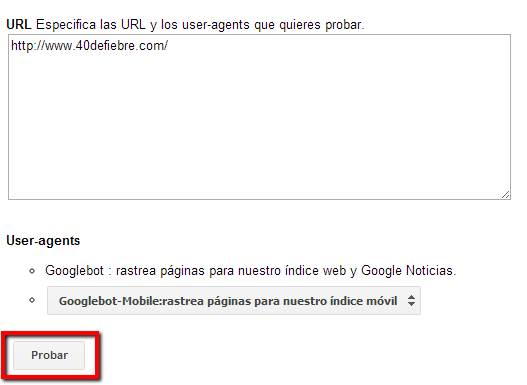 En el caso de que haya algún error con el archivo te aparecerá un icono de error donde podrás ver los fallos que ha detectado.
En el caso de que haya algún error con el archivo te aparecerá un icono de error donde podrás ver los fallos que ha detectado.Meta etiqueta robots
Las meta etiquetas se utilizan para decirle al robot de Google si puede o no indexar esa página y seguir los links que contiene. Lo que tenemos que comprobar es que en ninguna de las páginas que queremos que Google indexe aparezca esto en el código:<meta name=”robots” content=”noindex, nofollow”>Para saber rápidamente si alguna página tiene está etiqueta usa de nuevo Screaming Frog clicando en la pestaña directives y buscando el campo de Meta Data 1:
 Una vez tengas todas las páginas con está etiquetas solo tienes que eliminarlas.
Una vez tengas todas las páginas con está etiquetas solo tienes que eliminarlas.Frecuencia de cacheo muy baja
Una vez que Google indexa por primera vez una página determina con qué frecuencia volverá a visitar esa página en busca de actualizaciones, esto depende la autoridad y relevancia del dominio al que pertenezca esa página y de la frecuencia con que se actualice.Para saber cuál es la frecuencia de cacheo de tu página tiene que comprobar de manera manual los días que pasan entre un cacheo y otro usando el comando “cache:www.ejemplo.com” en Google:
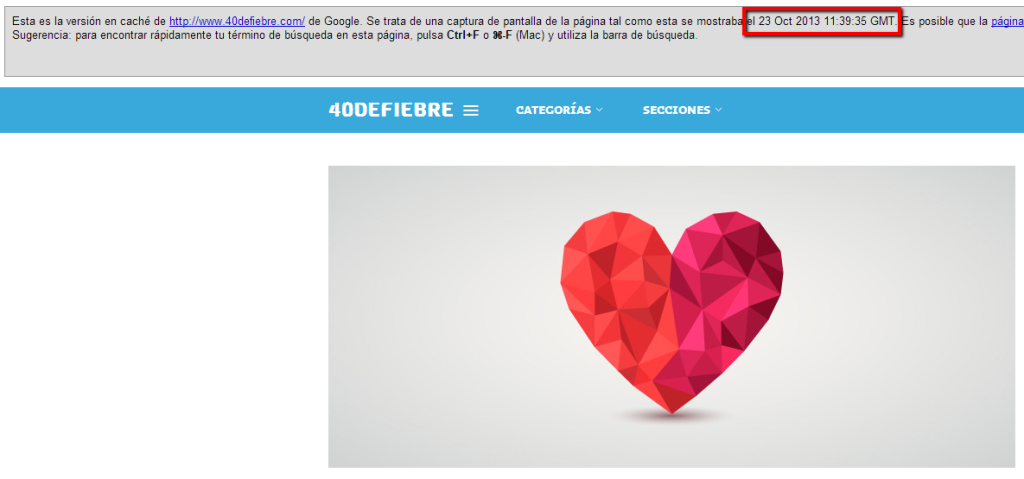 Compruébalo todos los días hasta que Google la vuelva a cachear, entonces sabrás cual es la frecuencia.
Compruébalo todos los días hasta que Google la vuelva a cachear, entonces sabrás cual es la frecuencia.Si consideras que la frecuencia es muy baja puede deberse a 4 motivos:
- Tu web no es lo suficientemente relevante para que Google pasee más a menudo por ella
- No actualizas a menudo el contenido de tu web
- Tu web da demasiados errores de servidor y 404, lo que hace que Google considere que tu página ha perdido relevancia. Para comprobar si la página tiene este tipo de errores consulta en Google Webmater Tools > Rastreo > Errores de rastreo
- Has ralentizado La frecuencia de rastreo en Google Webmaster Tools, para modificarla ve a Google Webmaster Tools > Configuración de sitio, lo ideal es dejar que Google decida

Google tiene más páginas indexadas
Seguramente la razón por la que haya más páginas indexadas de las que realmente hay en tu web es que tengas contenido duplicado o que Google este indexando páginas que no quieres que se indexen. Puedes consultar en Google Webmaster Tools > Aspecto de la búsqueda > Mejoras HTML si tienes páginas duplicadas.Contenido duplicado
Tener contenido duplicado significa que para varias URLs tenemos el mismo contenido, es un problema muy común que muchas veces es involuntario y que además puede acarrear una penalización de Google, estos son los principales motivos del contenido duplicado.“Canonicalización” de la página
Este es el motivo más común de contenido duplicado, se produce cuando tu página de inicio tiene más de una URL:- ejemplo.com
- www.ejemplo.com
- ejemplo.com/index.html
- www.ejemplo.com/index.html
Solución
Tienes 3 opciones:
- Hacer una redirección en el servidor para asegurarte de que solo hay una página que se muestre a los usuarios.
- Definir que subdominio quieres que sea el principal (“www” o “no-www”) en Google Webmaster Tools. Cómo definir el subdominio principal
- Añadir una etiqueta “rel=canonical” en cada versión que apunte a las que tu consideres la correcta
Parámetros en la URL
Existen muchos tipos de parámetros, sobre todo en e-commerce: filtros de los productos (color, talla, puntuación, etc.), ordenación (precio menor, por relevancia, precio mayor, en cuadricula, etc.) y sesiones de usuarios. El problema es que muchos de estos parámetros no cambian el contenido de la página, eso genera muchas URLs para el mismo contenido.- www.ejemplo.com/boligrafos?color=negro&precio-desde=5&precio-hasta=10
Solución
La solución para cualquier problema con los parámetros es añadir una etiqueta “rel=canonical” hacia la pagina original, con esto podrás evitar cualquier tipo de confusión por parte de Google con la página original.
Otra posible solución es indicar a Google a través de Google Webmaster Tools > Rastreo > Parámetros de URL que parámetros debe ignorar a la hora de indexar páginas en tu web.
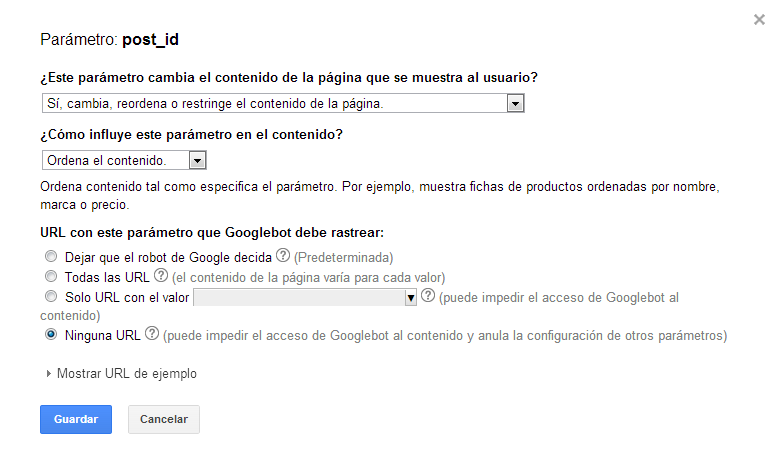
Paginación
Cuando un articulo, lista de productos o páginas de etiquetas y categorías tienen más de una página pueden aparecer problemas de contenido duplicado aunque las páginas tienen contenido diferente, todas están centradas en el mismo tema. Esto es un problema enorme en las páginas de e-commerce donde tienen cientos de artículos en la misma categoría.Solución
Actualmente existe las etiquetas rel=next y rel=prev que permiten a los motores de búsqueda saber que todas las paginas pertenecen a una misma categoría/publicación, no indexando todas las páginas y centrando todo el potencial de posicionamiento en la primera página.
Cómo usar los parametros NEXT y PREV
Otra solución es buscar el parámetro de paginación en la URL e introducirlo en Google Webmaster Tools para que no se indexe.
Páginas que no queremos que se indexen
La diferencia entre estas páginas y las que clasificamos como contenido duplicado es que estas son páginas únicas pero que por un motivo u otro no queremos que Google la indexe. Para comprobar si hay páginas que no quieres que se indexen pero se están indexando, ya sean páginas privadas o las páginas del proceso de compra de un e-commerce, solo hay que hacer la búsqueda “site:www.ejemplo.com” y comprobar si aparecen dichas páginas en los resultados de búsqueda.En caso de que esas páginas aparezcan podemos hacer dos cosas:
- Añadir la etiqueta <meta name=”robots” content=”noindex, nofollow”>en las páginas que no queramos ver indexadas
- Modificar el archivo “robots.txt” para que no se indexen.
User-agent: *
Disallow: /wp-admin/
Disallow: /wp-includes/
Contenido
¿Por qué es importante el contenido?
Lo primero que se viene a la cabeza es que para Google “El contenido es el rey”, pero para simplificarlo más una página nunca va a posicionar por algo que no contenga, es decir, si quieres posicionar para “Halloween” y no hablas de Halloween en tu web no lo vas a conseguir.Vamos a dividir el contenido de la web en dos partes:
- SEO On-Site: Sería el contenido que no vemos, es decir, las etiquetas HTML
- Textos
SEO On-Site: Meta Etiquetas
En esta sección nos vamos a referir al SEO On-Site como las meta-etiquetas (teniendo el cuenta que dentro del SEO On-Site también entraría la velocidad de carga o el texto). Las etiquetas más importantes que debemos tener en cuenta son las siguientes.Title
La etiqueta title es el elemento más importante dentro de las meta-etiquetas es lo primero que aparece en los resultados en Google y es lo que se muestra cuando la gente pone el enlace en las redes sociales (excepto Twitter).
Hay que tener en cuenta una serie de cosas a la hora de optimizar el title
- La etiqueta debe estar en la sección del código
- Cada página ha de tener un título único
- No debe de exceder los 70 caracteres, si no aparecerá cortado.
- Debe de ser descriptivo con respecto al contenido de la página
- Debe de contener la keyword para la que estemos optimizando la página
- Nunca debemos abusar de las keywords en el titulo, esto hará que los usuarios desconfíen y que Google piense que estamos intentando engañarlo
Meta Description
Aunque no es un factor de posicionamiento, afecta de manera considerable a la tasa de clicks (click-through rate) en los resultados de búsqueda.
Para la meta description seguiremos los mismos principios que con el título, solo que la longitud de esta no debe de exceder los 155 caracteres. Tanto para los títulos y la descripciones debemos de evitar la duplicidad, esto lo podremos comprobar en Google Webmaster Tools > Aspecto de la búsqueda > Mejoras HTML.
Meta Keywords
En su momento las meta keywords fueron un factor muy importante de posicionamiento pero en cuanto Google vio lo fácil que es manipular los resultados de búsqueda lo eliminaron como factor de posicionamiento. Dado que su único uso en la actualidad es para categorizar las noticias en Google News lo mejor que puedes hacer es eliminarlas.
Etiquetas H1, H2, H3…
Las etiquetas H1, H2, etc; son muy importantes para tener una buena estructura de información y una buena experiencia de usuario ya que definen jerarquía del contenido, algo que mejorará el SEO de manera considerable. Debemos de darle importancia al H1 porque normalmente está en la parte más alta del contenido y ya que cuanto más arriba este una de keyword más importante les dará Google.
Google Authorship
Una de las etiquetas que más importancia ha ganado en el último año, está etiqueta vincula un contenido a un perfil de Google+ mostrando un resultado de búsqueda enriquecido aunmentando así el CTR (Click Through Rate). Un resultado de búsqueda enriquecido con authorship se vería así:
 Para implementar correctamente esta etiqueta tienes que seguir una serie de pasos:
Para implementar correctamente esta etiqueta tienes que seguir una serie de pasos:- Tener un perfil de Google+
- Asegúrate de que en tu foto de perfil se reconoce tu cara
- En la página del contenido debe aparecer tu nombre
- El nombre del autor tiene que ser el mismo que el de Google+
- Debes vincular tu página de Google+ con tu web añadiendo el enlace en “contribuye en”

- Tienes que vincular el contenido con la página de Google+ en el código de la página
 Etiqueta “alt” en la imagen
Etiqueta “alt” en la imagenLa etiqueta “alt” en las imágenes se añade directamente en el propio código de la imagen:
<img src=”http://www.ejemplo.com/ejemplo.jpg” alt=”keyword molona” />
Esta etiqueta tiene que ser descriptiva con respecto a la imagen y contenido que rodea a la imagen ya que es lo que lee Google al ver una imagen y uno de los factores que usa para posicionarla en Google Imágenes.
Textos
El contenido es la parte más importante de una web y por mucho que tu web este muy bien optimizada a nivel SEO, si el contenido no es relevante con respecto a las búsquedas que realizan los usuarios nunca vas a aparecer en las primeras posiciones.Para crear buen contenido que siga las directrices de Google hay que tener una serie de cosas en cuenta:
- La página tiene suficiente contenido, aunque no hay una medida estándar de cuanto es “suficiente” se recomienda que al menos contenga 300 palabras
- El contenido tiene que ser relevante, útil para el lector, simplemente preguntándonos si nosotros leeríamos eso, nos daremos la respuesta
- Los textos deben contener las keywords para las que queremos posicionar
- Tiene que estar bien escrito, es decir, no puede tener faltas de ortografía, errores de sintaxis o datos erroneos
- Ha de ser fácil de leer, si no se nos hace tediosa la lectura, estará bien.
- Tiene que ser enlazable, si no le facilitamos al usuario como compartirlo es muy probable que no lo haga. Pon botones de compartir en redes sociales en lugares visibles de la página que no estorben la visualización del contenido, ya sea un vídeo, una foto o texto
- Debe ser actual, cuanto más actualizado este tu contenido mayor será la frecuencia de rastreo de Google en tu web y mejor será la experiencia del usuario.
Problemas con el contenido
En el SEO, cómo en todo, si nos pasamos con algo puede convertirse en un problema, para Google es muy importante que los textos estén bien optimizados pero sin pasarse, en caso de que detecte un sobre optimización del texto podemos caer en un penalización. Por eso debemos evitar los siguientes errores:Keyword Stuffing
El keyword stuffing es una técnica considerada black hat SEO por Google en la que se redacta un texto con una gran densidad de palabras clave o KW density con el objetivo de posicionar por esa palabra clave.
Google penaliza con mucha frecuencia este tipo de sobre-optimización. Para evitar cualquier tipo de acción negativa por parte de Google los textos siempre deben redactarse para proporcionar valor al usuario de la forma que más se adapte a tu perfil de público si el texto consigue dar una información mejor, más original, diferente, mejor sintetizada o que aporte más valor, eso será un indicador para Google mucho mejor que cualquier variación en el número de keywords que haya en el texto.
Canibalización
La canibalización de keywords ocurre cuando en una web hay varias páginas que compiten por las mismas palabras clave, con lo que se está confundiendo al motor de búsqueda al no saber que página es la más relevante para esa palabra clave, causando una perdida en el posicionamiento.
Este problema es muy común en los e-commerce que al tener varias versiones de un mismo producto atacan con todas ellas a las mismas keywords, por ejemplo, si vendes un libro en versión tapa blanda, tapa dura y versión digital tendrás 3 páginas con prácticamente el mismo contenido. Para solucionarlo lo mejor crear una página principal del producto desde donde se acceda a las páginas de los diferentes formatos en las que incluiremos una etiqueta canonical a la página principal del producto como hace Amazon:
 Lo óptimo siempre será centrar cada keyword en una sola página para evitar cualquier problema de canibalización.
Lo óptimo siempre será centrar cada keyword en una sola página para evitar cualquier problema de canibalización.Texto oculto para Google
Google cada vez es más “inteligente” a la hora de leer el contenido incluido en una web, ya es capaz de leer el texto incluido dentro del Javascript y tarde o temprano acabará leyendo el texto dentro de las imágenes, pero como de momento no es así lo mejor que podemos es evitar publicar texto importante dentro de las imágenes.
Factores técnicos: Velocidad de carga
La velocidad de carga además de ser un factor importantísimo en el posicionamiento web hará que tus usuarios se enamoren de tu web, porque ¿a quién no le gusta entrar en un página web y que cargue en un momento? En esta sección veremos cómo detectar que es lo que ralentiza la carga de tu web y como solucionar alguno de los problemas más comunes.Medir la velocidad de carga con Google Page Speed
Google Page Speed es la herramienta gratuita que ofrece Google para medir la velocidad de carga de una página que además da información sobre qué es lo que ralentiza la carga y cómo arreglarlo.Lo primero que tienes que hacer es usar la herramienta en la home de tu web
 Lo primero que te muestra la herramienta es la “nota media” de tu
web, una vez sepas esto es hora de saber qué es lo que más está
ralentizando tu web, hay tres tipos de mejoras según su prioridad:
Lo primero que te muestra la herramienta es la “nota media” de tu
web, una vez sepas esto es hora de saber qué es lo que más está
ralentizando tu web, hay tres tipos de mejoras según su prioridad: Por supuesto lo primero que tienes que hacer es centrarte en las
mismas importantes, solo tiene que clicar en icono y se desplegará la
explicación completa con unos cuantos ejemplos:
Por supuesto lo primero que tienes que hacer es centrarte en las
mismas importantes, solo tiene que clicar en icono y se desplegará la
explicación completa con unos cuantos ejemplos: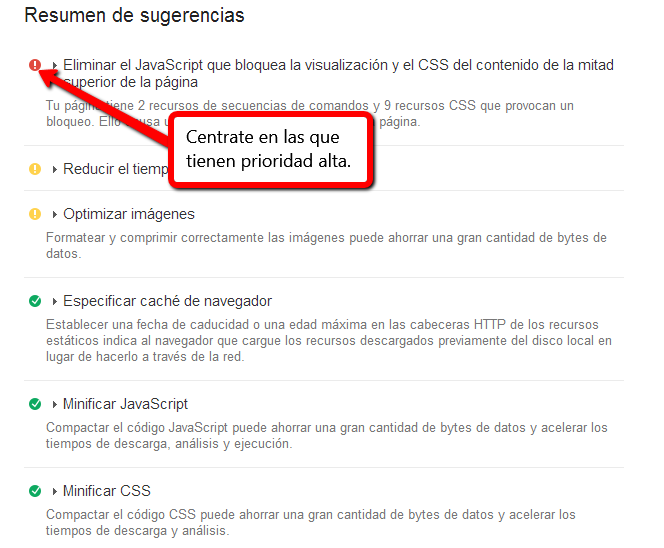 Lo siguiente que debes hacer es usar la herramienta en las páginas
interiores de tu web, sobre todo en las que son diferentes a la home,
por ejemplo, en 40defiebre tenemos el diccionario de Inbound Marketing que es completamente diferente a nuestra home
Lo siguiente que debes hacer es usar la herramienta en las páginas
interiores de tu web, sobre todo en las que son diferentes a la home,
por ejemplo, en 40defiebre tenemos el diccionario de Inbound Marketing que es completamente diferente a nuestra home No nos podemos olvidar de la velocidad de carga en los dispositivos
móviles. Haz el mismo proceso que con la versión de escritorio
No nos podemos olvidar de la velocidad de carga en los dispositivos
móviles. Haz el mismo proceso que con la versión de escritorio
Encontrar imágenes que optimizar en la web
Las imágenes es uno de los factores que más ralentizan una web y que además es muy fácil que caigamos en él.Con Google imágenes
- Lo primero que tienes que hacer es usar el comando “site:” para buscar todas las imágenes de tu web
- Filtra las imágenes según el tamaño, empieza con un tamaño intermedio para descartar todas las imágenes pequeñas:
- Busca las fotos que sepas que no se muestran grandes en tu web y mira el tamaño real que están ocupando:
- Reduce en lo posible el tamaño de la imagen y pásala por Yahoo Smush.it, esta herramienta optimizará tu imagen al máximo eliminando información innecesaria de ella.

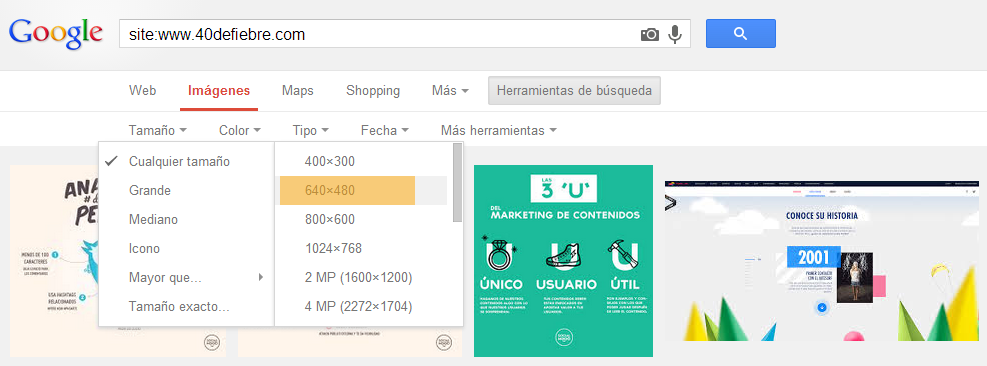
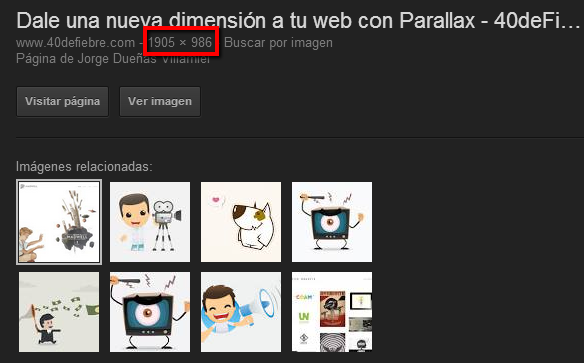
Este es el método más rápido de ver la imágenes redimensionadas de la un página concreta, el único pero es que tienes que ir página por página:
- Instala Web developer para Mozilla Firefox o Google Chrome
- Re dimensiona las imágenes con Google Chrome
- Re dimensiona las imágenes con Mozilla Firefox
- Reduce en lo posible el tamaño de la imagen y pasala por Yahoo Smush.it, esta herramienta optimizará tu imagen al máximo eliminando información innecesaria de ella.
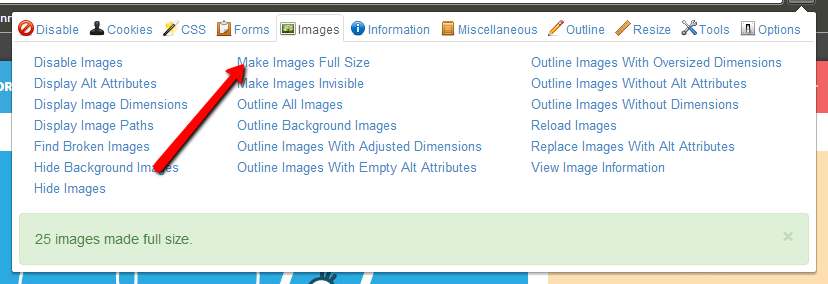
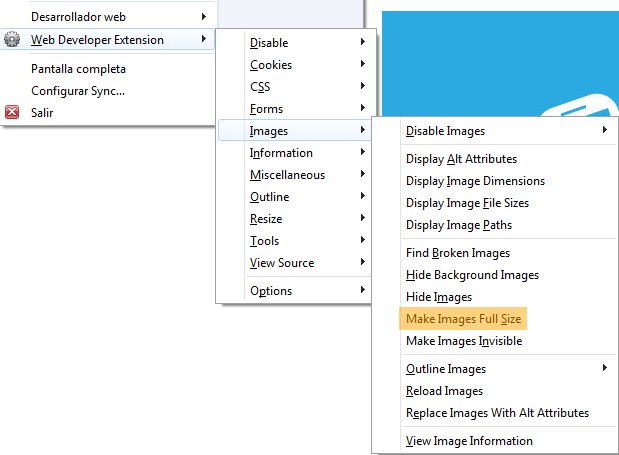
Lo mejor de buscar imágenes con Screaming Frog es que te puedes descargar un CSV con todas las URLs de las imágenes:
- Descárgate Screaming Frog
- Introduce tu web en el programa y clica en la pestaña de “images”
- Filtra las imágenes que pesen más de 100kb y exportalo
- Cómo en la dos anteriores, reduce en lo posible el tamaño de la imagen y pasala por Yahoo Smush.it, esta herramienta optimizará tu imagen al máximo eliminando información innecesaria de ella.


Herramientas para optimizar la velocidad de tu web
- Google Closure: Es un programa de Google que permite minificar los Javascript en un solo archivo.
- LESS: LESS es un programa que permite crear CSS de forma automática además de optmizarlos haciéndolos más pequeños. Para Windows e iOs
- Yahoo! Mush.It: Está herramienta de Yahoo! elimina información innecesaria de las imágenes sin que disminuya la calidad de las mismas
- Yslow de Yahoo!: Yslow es la extensión de Yahoo! para medir la velocidad de una página. Tiene la ventaja de que la puedes usar sin tener que abrir ningún programa en cualquier momento
- Pingdom Speedtest: Junto con Google Page Speed es la herramienta más usada para medir la velocidad de carga. Lo mejor de esta herramienta es que te detalla el orden en que se cargan las cosas, el tiempo que tardan en cargarse y el nivel de optimización de cada tiempo de carga.
 Data, data everywhere yet nary an insight in sight.
Data, data everywhere yet nary an insight in sight.




 We have access to more data than God wants anyone to have. Thus it is
not surprising that we feel overwhelmed, and rather than being data
driven we just get paralyzed. Life does not have to be that scary. In
fact a data driven life is sexiest digital life you can imagine.
We have access to more data than God wants anyone to have. Thus it is
not surprising that we feel overwhelmed, and rather than being data
driven we just get paralyzed. Life does not have to be that scary. In
fact a data driven life is sexiest digital life you can imagine.

